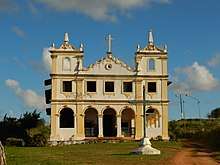Church of Our Lady of the Conception of Comandaroba
The Church of Our Lady of the Conception of Comandaroba (Portuguese: Igreja de Nossa Senhora da Conceição de Comandaroba, or simply the Igreja de Comandaroba) is an 18th-century Roman Catholic church in Laranjeiras, Sergipe, Brazil. It was established by the Jesuits and was passed to the Carmelite order after its construction. The church was listed as a historic structure by National Institute of Historic and Artistic Heritage (IPHAN) in 1941. The church is dedicated to Our Lady of the Conception and is constructed in the Baroque style.[1][2][3][4]
| Church of Our Lady of the Conception of Comandaroba | |
|---|---|
Igreja de Nossa Senhora da Conceição de Comandaroba | |
 Church of Our Lady of the Conception of Comandaroba | |
| Religion | |
| Affiliation | Catholic |
| Rite | Roman |
| Location | |
| Municipality | Laranjeiras |
| State | Sergipe |
| Country | Brazil |
 Location of the Church of Our Lady of the Conception of Comandaroba in Brazil | |
| Geographic coordinates | 10.808217°S 37.182463°W |
| Architecture | |
| Style | Baroque |
| Founder | Society of Jesus |
| Completed | 1734 |
National Historic Heritage of Brazil | |
| Designated | 1941 |
| Reference no. | 299 |
History
The Church of Our Lady of the Conception of Comandaroba was one of two Jesuit properties in present-day Laranjeiras. Laranjeiras was home to indigenous people prior to the arrival of the Portuguese; the first Portuguese settlers arrived in the 16th century, and the 17th century was marked by the Dutch attacks and invasion of the region. The Jesuits initially built a retreat, the Casa do Retiro, in the late 17th century. They then purchased a house at Comandaroba and completed a church on the site in 1734; it was part of the larger Comandaroba Plantation. The house at Comandaroba may have been established by the Capuchins. The Jesuits left Laranjeiras prior to the expulsion of the Jesuits from Brazil in 1759. Colonel Felipe Pereira do Lago and his wife donated the Comandaroba Plantation to the Carmelite Order of Bahia in 1756. A parish church was established in Laranjeiras at the end of the 18th century, the Parish Church of the Sacred Heart of Jesus. The Church of Comandaroba belonged to the Carmelites until the early 19th century.[2][5][1]
Structure
The building has a structure consisting of mixed masonry of stone and brick. The church has a rectangular plan with a small nave, chancel, and two sacristies. The pulpit as has a lion, sculpted in stone, at the base of the pulpit. The sacristies and chancel are connected by entrance doors and rectangular windows with lattice screens.[2]
Protected status
The Church of Our Lady of the Conception of Comandaroba was listed as a historic structure by the National Institute of Historic and Artistic Heritage in 1941. It was listed in the Book of Historical Works no. 299. The Parish Church of the Sacred Heart of Jesus was also listed as a historic structure by IPHAN in the same year.[3][5]
References
- Freire, Felisbello (1891). História de Sergipe, (1575-1855). Rio de Janeiro, Brasil: Typographia Perseverauza. p. 207.
- Moura Filha, Maria Berthilde (2013). "Church of Our Lady of the Conception (Comandaroba)". Lisbon, Portugal: Heritage of Portuguese Influence/Património de Influência Portuguesa. Retrieved 2020-02-20.
- "Lista de Processos de Tombamento" (PDF) (in Portuguese). Brasília, Brazil: Instituto do Patrimônio Histórico e Artístico Nacional. 2020. Retrieved 2020-02-20.
- Sergipe. Subsecretaria de Cultura e Arte (1984). O Tradicionalismo católico no Nordeste: relatório de pesquisa. Aracaju, Sergipe: Governo do Estado de Sergipe, Secretaria de Estado da Educação e Cultura, Subsecretaria de Cultura e Arte. pp. 8–9.
- Passos, Lucas Santos (2015). Tombamentos de templos religiosos em Laranjeiras/Sergipe (PDF) (in Portuguese). São Cristóvão: Universidade Federal de Sergipe. pp. 39–42. Retrieved 2020-02-19.
| Wikimedia Commons has media related to Igreja de Nossa Senhora da Conceição de Comandaroba. |